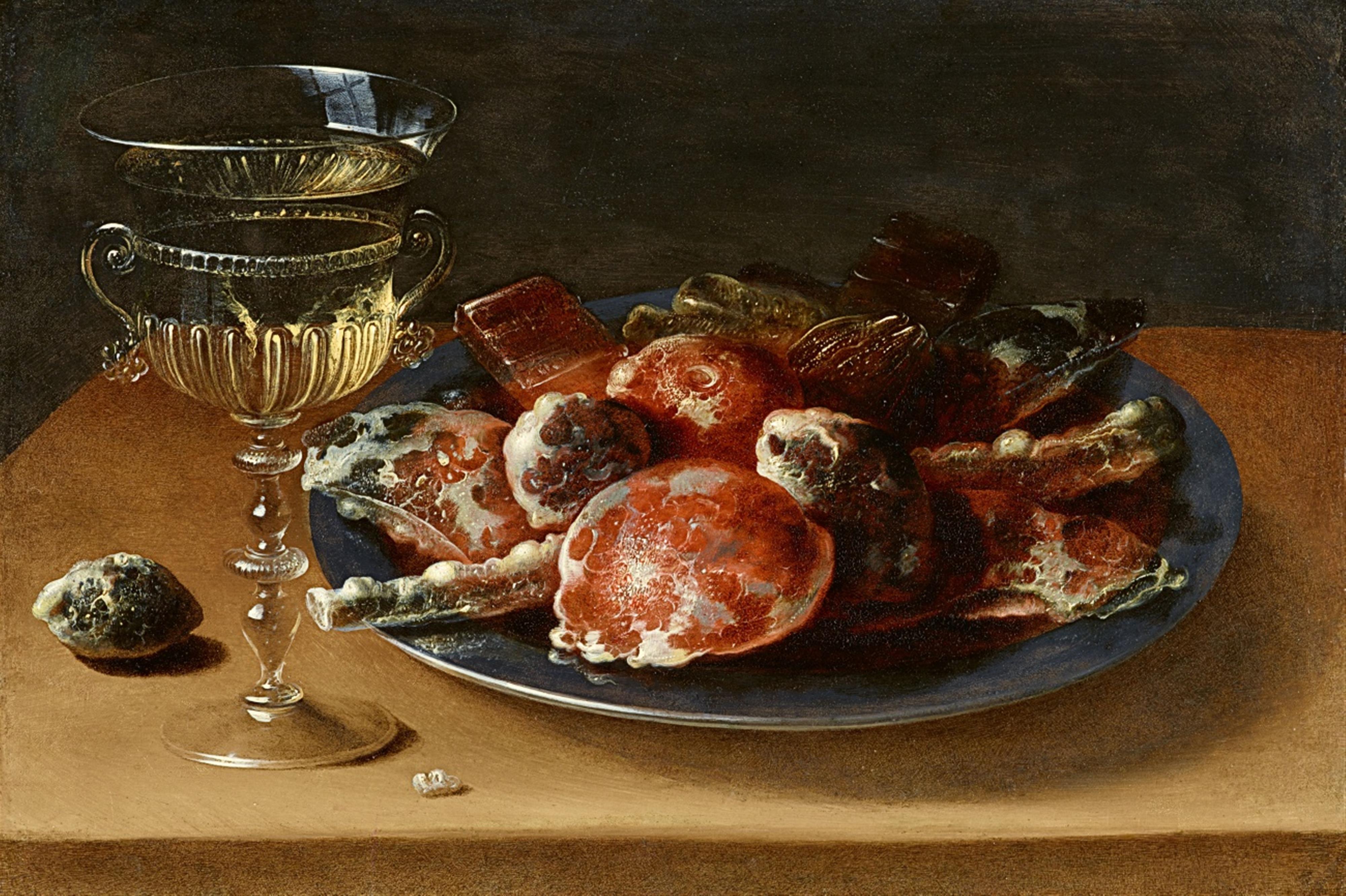Ossias Beert
Still Life of Sweets on a Pewter Plate and a Façon de Venise Wineglass, on a Wooden Ledge
Oil on panel. 25 x 35.5 cm.
“This is an excellent example of the work of Osias Beert I”, wrote Fred G. Meijer in October 2020 in a short statement about the present still life, dating it around 1610. Alongside Jan Brueghel the Elder (1568-1625) and Ambrosius Bosschaert the Elder (1573-1621), Osias Beert is one of the leading still life painters of the early 17th century, who decisively influenced the development of this genre. Only a few of his works are signed and none are known to be dated.
As so often with this genre, the present still life with a wine glass à la façon de venise and a pewter plate with candied fruit can be seen as an opportunity for social representation, a symbol of the commissioning party's cultivated way of life, affluence and their social status. Among the early sweet goods that were consumed in medieval Europe were fruits candied in sugar, usually served at the end of a meal. They were in no means an everyday dish, but rather served as demonstration of refinement practiced at the time by the upper class. The accompanying dinnerware in the form of a pewter plate and a fine Venetian wine glass, suitably matched to the delights offered here, are also a sign of opulence and splendour. Sweet goods, in the form of candied fruits here, symbolise abandonment to desire and lust and thus admonish the viewer to remain modest. Even the wine glass refers to earthly pleasures.
Despite their sometimes rich content, Osias Beert's still lifes are always characterised by a pronounced clarity and balance in their composition. The warm colouring and the staging of the objects in front of a dark background on a tabletop are also characteristics of his works.
Paintings by Osias Beert can be found in private and public collections including the Rijksmuseum in Amsterdam, in the Gemäldegalerie in Berlin, in the Koninklijk Museum voor Schone Kunsten in Brussels, the Wallraf-Richartz-Museum in Cologne, Museo Nacional del Prado in Madrid, the Musée du Louvre in Paris and the National Gallery of Art in Washington.
The present painting is registered with the RKD, The Hague, as an authentic piece by Osias Beerts as no. 59323.
We are grateful to Dr Fred G. Meijer for his confirmation of the authenticity on the basis of high resolution photographies.
Provenance
With P. de Boer, Amsterdam, 1968 -1969;
Private collection, Paris, 1983;
With Galerie Sanct Lucas, Vienna, 1996 -1997 (exhibited at TEFAF, Maastricht, March 1996 and 1997);
With Derek Johns, London, 1997-1998 (exhibited at Salon des Beaux-Arts, Paris, September 1997, with illustr. in cat. p. 76. and exhibited at TEFAF, Maastricht, March 1998);
Anonymous sale, Sotheby's, New York, 28 January 1999, lot 312;
With Galerie Edel, Cologne, 2002 (exhibited at TEFAF, Maastricht, March 2002, with illustr. in cat. p. 84).
Literature
Edith Greindl: Les peintres flamands de la nature morte au XVIIe siecle, 1983, p. 188, fig. 28;
Gabriel Diss and Laurent Turnherr (eds.): Un cabinet imaginaire. Natures mortes et vanités du XVIIème siècle: biographie des peintres de l'exposition, Musée départemental Georges de La Tour, Vic-sur-Seille, exh. cat., Bremen 2005, p. 12-13.
Exhibitions
Un cabinet imaginaire. Natures mortes et vanités du XVIIème siècle, Vic-sur-Seille, Musée départemental Georges de La Tour, 10 May - 4 September 2005.

